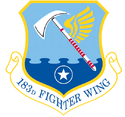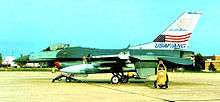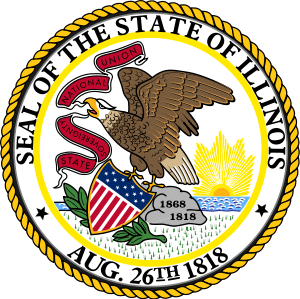183rd Fighter Wing
| 183d Fighter Wing | |
|---|---|
|
170th Fighter Squadron - 60th Anniversary F-16. USAF F-16C block 30 #87-0296 from the 170th FS is leaving Springfield IAP for its final training flight in September 2008 before the unit's inactivation | |
| Active | 15 October 1962-present |
| Country |
|
| Allegiance |
|
| Branch |
|
| Type | Wing |
| Part of | Illinois Air National Guard |
| Garrison/HQ | Capital Airport Air National Guard Station, Springfield, Illinois |
| Commanders | |
| Current commander | Colonel John Patterson |
| Insignia | |
| 183d Fighter Wing emblem |
 |
The 183d Wing is a unit of the Illinois Air National Guard, stationed at Capital Airport Air National Guard Station, Springfield, Illinois. If activated to federal service, the wing is gained by the United States Air Force Air Combat Command.
Overview
A non-flying wing, the 183d Wing is tasked with augmenting Component Numbered Air Force (C-NAF) in both the Air and Space Operations Centers (AOC) and the Air Force Forces staff (AFFOR), A1 to A9. The mission of the 183d Fighter Wing consists of supporting the assigned groups and tenant units with traditional military services as well as all services for force sustainment including civil engineering, personnel, logistics, communications, medical, security, family support, and all other host services.
Units
The primary unit of the 183d Wing is the 183d Air Operations Group (183 AOG).
The 183 AOG is capable of augmenting C-NAF staffs worldwide, therefore affording AOG personnel the opportunity to train at various locations - CONUS and OCONUS. The role of the AOG is to assist the AOC in organizing, planning, and executing the "air war" in a contingency or campaign and assist the AFFOR staff in bedding down Air Force forces in the theater. The 183rd AOG is aligned with Twelfth Air Force / AFSOUTH at Davis-Monthan AFB, Arizona.
Other units of the 183 WG are:
- 183d Medical Group
- 183d Mission Support Group
- 183d Maintenance Squadron
- Operates the Centralized Repair Facility (CRF)
History
On 15 October 1962, the Illinois Air National Guard 170th Tactical Fighter Squadron was authorized to expand to a group level, and the 183d Tactical Fighter Group was established by the National Guard Bureau. The 170th TFS becoming the group's flying squadron. Other squadrons assigned into the group were the 183d Material Squadron, 183d Combat Support Squadron, and the 183d USAF Dispensary.
The 170th Tactical Fighter Squadron was equipped with Republic F-84F Thunderstreaks. It continued to fly the aircraft throughout the 1960s. The squadron was not activated for service during the Vietnam War, although from 1968 to 1971 many of its personnel were activated and some saw service in Southeast Asia. All F-84Fs were grounded in November 1971, after a 170th pilot was killed when his plane lost a wing during exercises at the Hardwood Gunnery Range in Findley, Wisconsin. The accident was caused by the "milkbone" joining bolt in the main wing which had been weakened by years of flying and failed in-flight. All RF-84F aircraft were immediately grounded after inspections of other F-84Fs in the Air National Guard found the same issue affected many other aircraft. The problem was deemed too widespread to justify the economic repair of the aircraft, and it was decided to retire the ANG's fleet of F-84Fs and replace them with more modern aircraft. In 1972 the 170th F-84s were given a 2G ferry flight permit to the Aerospace Maintenance and Regeneration Center at Davis-Monthan Air Force Base, the 170th having the distinction of flying the F-84F longer than any other USAF/ANG squadron.
In January, 1972, the 183d Fighter Group was the first Air National Guard unit to receive the McDonnell F-4C Phantom II, with its aircraft being Vietnam War aircraft that were returning from Southeast Asia. Along with the F-4C, a flight of RF-4C Phantom II reconnaissance aircraft were received. In 1981, the F-4Cs were exchanged for the F-4D Phantom II.
Post Cold War era

The 170th saw its first General Dynamics F-16A Fighting Falcon on 7 June 1989 when two landed at Capital Airport to replace the aging F-4D Phantom II. By May 5, 1990, the 170th TFS was operational with the F-16A. Its mission at the time was fighter attack and was provided the Block 15 for this job. On 15 March 1992 the squadron changed designation from the 170th Tactical Fighter Squadron to the 170th Fighter Squadron when its parent 183d Fighter Group adopted the new Air Force Objective organization plan.
During early 1994 the 170th FS started to exchange their Block 15 F-16A/B for Block 30 F-16C/D Fighting Falcon with the big inlet design. Most of the Block 15s were retired straight to AMARC. During the 1990s, the unit conducted numerous overseas deployments, including six to Southwest Asia, two to Denmark, one to Panama, one to Curaçao, and one to Thailand.
Global War on Terrorism

After the September 11, 2001, attack, the 170th FS increased its capability by obtaining AN/AAQ-28(V) LITENING targeting pods in October 2001. Training with the new pod started immediately and included some internal personnel as some were trained on use of the pod as well as training from the Wisconsin ANG. The purpose of the training was to get ready for deployment in March 2002 for Operation Enduring Freedom.
Starting in January 2002 the 170th FS deployed for two weeks to Tucson Air National Guard Base, Arizona for final training with the LITENING pod. Initially the deployment in March 2002 was to be with two other ANG units but this changed due to Operation Noble Eagle air defense commitments. As a result, the 170th FS deployed by itself as the 170th Expeditionary Fighter Squadron (170 EFS). When the 170th EFS arrived it replaced the 18th EFS which was normally based at Eielson Air Force Base in Alaska. On top of duties over Afghanistan, the 170th FS also had to perform air interdiction missions over Iraq in support of Operation Southern Watch.
In the very early morning on 17 April 2002 while on deployment in Afghanistan a pilot in a two-ship formation from the 170th FS mistakenly bombed a Canadian force which was practicing live firing of its weapons near Kandahar, Afghanistan. Four soldiers were killed and eight were injured. This tragedy dogged the 170th FS for years and a trial against the pilots began in Springfield.
After more than two consecutive years deployed overseas the 170th FS participated in Operation Iraqi Freedom when they deployed to the region in October 2004.
BRAC 2005
The 2005 Base Realignment and Closure Commission committee report recommended the retirement of the block 30 F-16 Fighting Falcon, and the inactivation of the 170th Fighter Squadron. Despite challenges by the governor of Illinois in federal court, the aircraft began to be retired, and ultimately the US District Judge stated that there was not enough evidence to support that the region would suffer major harm by the closure of the unit. The last F-16 departed on 23 September 2008, marking the end of the flying mission for the 183d Fighter Wing.
Due to the outstanding quality of work historically exhibited by the 183d Fighter Wing, the new mission outlined by the BRAC commission recommended the facilities and notable skill sets of personnel assigned be realigned into a Centralized Intermediate Repair Facility.
Current status
Since BRAC, the 183d has been given an additional follow-on mission. The Component Numbered Air Force, including an Air and Space Operations Center 272and an Air Force forces staff, is an aerospace operation planning, execution, and assessment system for the Joint Forces Air Component Commander. It is the primary tool for commanding and executing air, space and cyber power.
The 183d Air Operations Group will augment Air Force headquarters staffs in planning, coordinating, allocating, tasking and controlling air, space and cyber operations in a theater of operations.
On November 2, 2014, the 183d Fighter Wing welcomed Colonel John Patterson as their new Commander. Colonel Patterson replaced Colonel (now Brigadier General) Ron Paul.
On March 4, 2017, the 183d Fighter Wing was redesignated as the 183d Wing (183 WG).
Lineage
- Designated 183d Tactical Fighter Group and allotted to the Air National Guard on 11 September 1962
- Extended federal recognition and activated on 15 October 1962
- Redesignated 183d Fighter Group on 15 March 1992
- Redesignated 183d Fighter Wing on 11 October 1995
- Redesignated 183d Wing on 04 March 2017
Assignments
- Illinois Air National Guard, 15 October 1962
- Gained by: Tactical Air Command
- Gained by: Air Combat Command, 1 June 1992 - present
Components
- 183d Operations Group, c. 1 March 1994 – 30 September 2008
- 170th Tactical Fighter (later Fighter) Squadron, 15 October 1962 – c. 1 March 1994
Stations
- Capital Airport Air National Guard Station, Illinois, 15 October 1962 – present
Aircraft
- Republic F-84F Thunderstreak, 1962-1971
- McDonnell F-4C Phantom II, 1972-1981
- McDonnall RF-4C Phantom II, 1973-1975
|
Decorations
References
![]() This article incorporates public domain material from the Air Force Historical Research Agency website http://www.afhra.af.mil/.
This article incorporates public domain material from the Air Force Historical Research Agency website http://www.afhra.af.mil/.
- ↑ Air Force Personnel Center Awards Search (Post-1991) Archived 2 September 2011 at the Wayback Machine.



